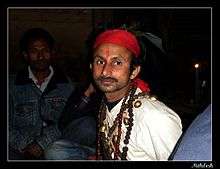Jhākri
Jhākri (Nepali: झाक्री) is the Nepali word for shaman. It is sometimes reserved specifically for practitioners of Nepali shamanism, such as that practiced among the Tamang people and the Magars; it is also used in the Indian states of Sikkim and West Bengal, which border Nepal.



Jhākri shamanism is practiced among numerous ethnic groups of Nepal and Northeast India, including the Limbu, Rai, Sunwar, Sherpa, Kami, Tamang, Gurung, Magars, Lepcha and Khas.[1] Belief in spirits is prevalent, hence also the fear of spirit possession.[2] Some vernacular words for jhākri are phedangbo in the Limbu language, maangpa or nakchhong in Khambu, and boongthing in Lepcha.
Jhākris perform rituals during weddings, funerals, and harvests. They diagnose and cure diseases. They are also known for performing a form of voluntary spirit possession, whereby they allow the supposed spirit of the dead to possess them for a brief time thereby allowing family members to communicate for a brief period of time. The practice is called "Chinta". Their practices are influenced by Hinduism, Tibetan Buddhism, Mun, and Bön rites.[3]
See also
- Banjhakri and Banjhakrini, shaman deities of Nepal
- Banjhakri Falls and Energy Park, a tourist attraction in Northeast India, with statues of jhākri
Notes
- Gulia 2005, pp. 153–4
- Gulia 2005, p. 152
- Gulia 2005, p. 168
References
- Gulia, Kuldip Singh (2005). Human Ecology of Sikkim: A Case Study of Upper Rangit Basin. Delhi: Kalpaz Publications. ISBN 81-7835-325-3.CS1 maint: ref=harv (link)